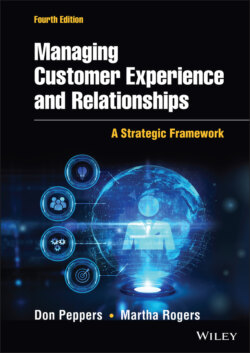Читать книгу Managing Customer Experience and Relationships - Don Peppers - Страница 22
How to Think about Customer Experience
ОглавлениеIn our view, any useful definition of customer experience should be based on straightforward language, while at the same time clearly differentiating the term from all the other marketing terms and buzzwords, such as customer service, brand preference, customer satisfaction, CRM, or customer loyalty. (See Chapter 3 for a deeper dive into customer experience.)
Customer experience is the sum total of a customer's individual interactions with a product or company, over time.
Individual means that we are talking about each different customer's own individual perception or impression of the experience. What you intend to provide a customer is not nearly so important as how the customer perceives what you provide.
Interactions occur in addressable or reciprocal channels, that is, outside of mass media. Marketing campaigns, taglines, and brand messages may be important, but they aren't interactions, so they lie outside the domain of customer experience. By contrast, improving your mobile app by, for instance, embedding voice or chat connections into it would definitely improve your customer experience. Similarly, when a company makes it easier for a prospect to find information about its product, that company is improving the customer experience even though the prospect may never actually become a customer.
When we talk about customer experience, we are only including direct contact. On the one hand, the interactions a customer has in person or online with other people or companies about a brand, product, or company are not really part of the customer experience. On the other hand, how your company actually engages with customers and prospects within various social channels is a direct interaction, and thus part of the customer experience.
Customer experience applies to all of a company's marketing, selling, and servicing entities. This includes dealers and distributors, marketing and advertising agencies, any retailers that sell your product, and any service firms that install or repair your company's product or that handle customer inquiries or interactions of any kind. For each of these interactions, you can contract out the task but not the responsibility—at least not as far as the customer is concerned.
Each customer's experience is not an isolated event; it accumulates through time. For instance, a company improves its customer experience by making it easier for a repeat customer to pull up what they ordered before, or configured before, and do it instantly, or when a call-center agent already knows what a prospect was recently looking up on the website.
A company cannot improve customer experience without considering all of these issues, including how each one impacts the others. Integrating all interaction channels is one of the first, and possibly the most important, steps a company can take to improve customer experience.
